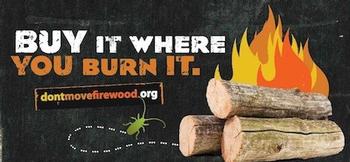Forest Health
Forest health has been defined by the production of forest conditions which directly satisfy human needs and by resilience, recurrence, persistence, and biophysical processes which lead to sustainable ecological conditions. Our definitions and understanding of forest health are also dependent on spatial scale.
- US Forest Service
Hot Topic Forest Health Issues
Forest Health Program
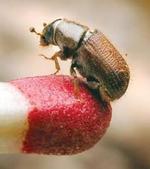
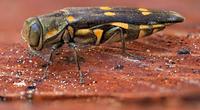
Useful Websites
California Forest Pest Council
California Oak Mortality Task Force
Hot Topic Forest Health Issues
Drought
There is a suite of forest health issues (invasive species, fire suppression, historically poor forest management, land-use change, and climate change to name a few) that can drive the decline and dieback of trees in a forest. The one I am currently most concerned about is Drought.
Many of the native tree species that occur in the coastal forests are well-adapted to drought and have an incredible ability to survive and persist through hot and dry seasons. But the persistent and severe drought conditions we have been experiencing the past few years are worsening already widespread forest health issues and resulting in new insect and disease outbreaks.
Forest Health and the Effects of Drought - Sonoma County Farm Bureau Farm News July 2021
While tree mortality is an inevitable and important part of a dynamic and healthy forest, the extent of decline and dieback over the past few years and especially starting this spring has become concerning. Many of the issues listed below can occur even without drought, but under drought conditions, they can be made worse.
——————
Ponderosa Pine and Other Conifer Morality
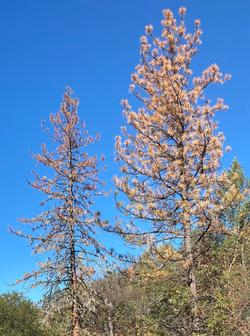
Dead ponderosa pine infested with western bark beetle.
|
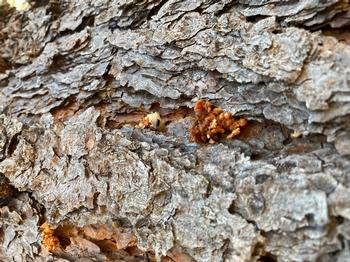
Pitch tubes from western pine beetle.
|
In early spring ponderosa pine began to die in eastern Mendocino County. Upon investigation, I found extensive western pine beetle and red turpentine beetle activity. I suspect the insects had established in fire-stressed trees and their populations had built up over the past few years, to the point where they were spreading to trees that had no or little fire damage and into areas where there had not yet been wildfire. My colleagues and I have now observed ponderosa pine morality from northern Mendocino to northern Napa. It would seem we are at the early stages of a western pine beetle outbreak I would suspect we will see a significant increase in pine mortality throughout the summer and into the next year. The drought conditions will further worsen the problem. Management includes removing dying trees to reduce pest pressure and thinning vegetation to improve stand health.
US Forest Service Forest Insect and Disease Leaflet - Western Pine Beetle
UC IPM - Bark Beetle Management
More recently, my CAL FIRE colleagues completed an aerial detection survey of southern Lake County and detected decline and mortality in other conifers including knobcone pine, Sierra foothill (grey or ghost) pine, and Douglas-fir. Similar to ponderosa pine, these bark beetle species outbreaks are likely associated with drought and poor forest health conditions.
CAL FIRE Aerial Detection Report, Lake and Napa Counties
Bark Beetle Outbreaks & Conifer Mortality in the North Coast Region
Tree Mortality in Northern California: Questions & Answers
——————
Tanoak Mortality
In addition to sudden oak death, a suite of other pathogens have been found to cause decline and mortality in tanoak. The impacts from these pathogens are likely exacerbated by drought conditions.
——————
Interior Live Oak and Ca Black Oak Decline and Mortality
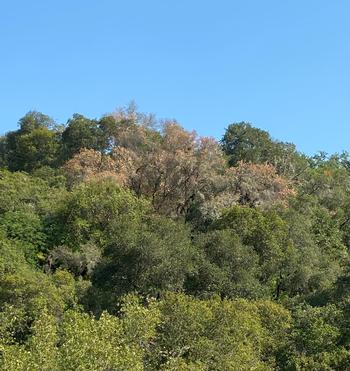
Declining interior live oak infested wtih western oak bark beetle.
|
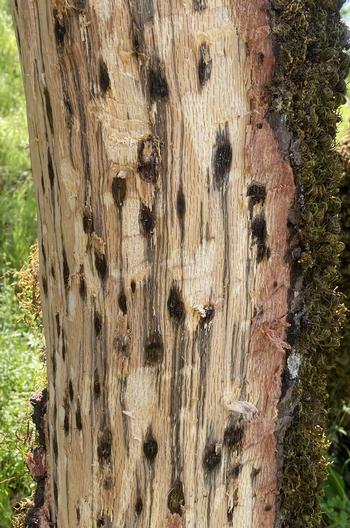
Ca black oak with western oak bark beetle galleries and foamy bark canker.
|
In late spring I was asked to take a look at several unhealthy interior live oak and CA Black oak in southern Mendocino County (Hopland). Upon investigating several clusters of declining and dead trees, I found evidence of western oak bark beetle, a native bark beetle that is attracted to stressed trees. While many of the declining trees had extensive evidence of the bark beetle activity, several trees had only a few galleries but were covered in cankers which were indicative of foamy bark canker, a disease caused by a pathogen the bark beetle vectors. While I have only observed this decline in the Hopland area, western oak bark beetle is found throughout California and could easily outbreak in other areas where oaks are highly drought stressed. Additionally, other native oak pests such as twig blight, branch canker, pit scale and invasive pests such as sudden oak death and Mediterranean oak borer are becoming more common in drought stressed trees throughout the Coastal Range. Management for western oak bark beetle can be difficult, but removing heavily infested trees and pruning and destroying infested material from relatively healthy trees can help control beetle populations.
——————
Mediterranean Oak Borer
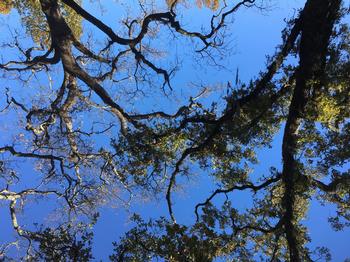
Declining valley oak infested with Mediterranean oak borer.
|
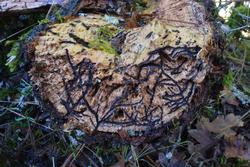
Mediterranean oak borer galleries.
|
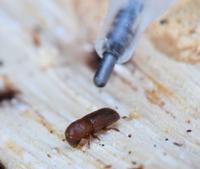
Mediterranean oak borer adult.
|
Mediterranean Oak Borer Pest Alert
Mediterranean Oak Borer website
The recently detected invasive Mediterranean oak borer (Xyleborus monographus) was found in valley oak in northern Napa Valley. Subsequent detections determined it had established in Middletown (Lake Co.) and eastern Sonoma Co. and a separate infestation near Sacramento. We are working with US Forest Service, Cal Fire, and CDFA to conduct trapping and research programs.
——————
Douglas-fir Branch Dieback
Over the past few years young Douglas-fir, especially those at the edges of stand or those encroaching into oak woodlands or grassland have exhibited branch flagging and dieback.
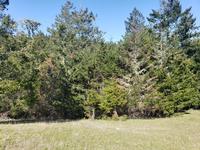
Branch dieback of Douglas-fir on the coast (Matt Greene)
|
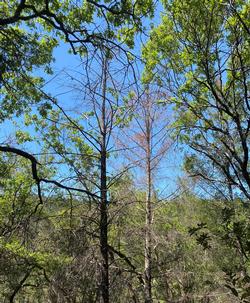
Dieback of Douglas-fir in an oak woodland
|
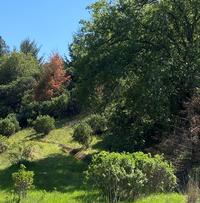
Dieback of Douglas-fir on edge of stand
|
In most of these trees with branch flagging I have found:
These native insects/diseases are typically not serious pests and fill an ecological role of helping to cull stressed trees and recycle nutrients. The activity of these pests usually picks up following favorable environmental conditions, but rarely results in extensive tree mortality. Management options usually include sanitation and improving vigor. Chemical controls can be used, but are not recommended.
However, I suspect the noticeable increase in mortality these past few years is driven primarily by two factors. The first is fire suppression, which has allowed natural forest succession to occur in the absence of disturbance and resulted in Douglas-fir populations building up and expanded. Many of the younger trees growing on what are low-quality sites for Douglas-fir (it does best on north-facing slopes with moist and mild climates) and are stressed and less resilient to pests. The second factor is drought. With the dense establishment of Douglas-fir on low-quality sites and in competition for limited resources, less water availability further stresses the trees making them more susceptible to pests and diseases.
Since I have yet to observe extensive decline and dieback in mature Douglas-fir stands and only in sites where the species has encroached, do not think of this as a serious forest health issue, but more of a natural correction for poor forest management through the exclusion of disturbance. Management includes removing dying trees to reduce pest pressure and thinning trees and vegetation to improve stand health.
——————
Twig and Branch Dieback of Oaks
This past summer I received multiple calls from land owners and managers regarding branch flagging and dieback on oaks.
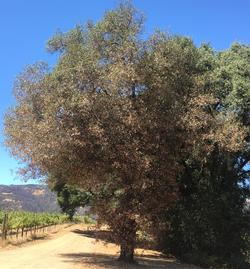
The likely cause of these symptoms were several native pests:
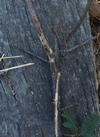
Twig canker and oak pit scale
|
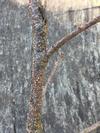
Oak pit scale
|
A wet and warm spring created ideal conditions for the outbreak of these native pests. Typically they do not result in tree mortality; however, they can present aesthetic concerns. Management usually includes sanitationn and improving tree vigor. Chemical controls are not recommended.
——————
Decline of Ornamental Redwood in Mendocino, Lake, and Sonoma Counties
Last summer (2019) I started receiving calls from landowners and managers regarding issues with ornamental redwood (Sequoia sempervirens). I have observed two general patterns: trees dying from the top down or declining canopies that appear discolored and drooping. While I have not explicitly determined the cause of the symptosms, there are several common health issues that can occur in off-site (i.e. planted outside of their natural range) ornamental redwood.
——————
Native oaks stressed by drought may recover
Forest Health Research
Below are some of the forest health issues were are addressing in our research and outreach Forestry Program, with the goal of helping land owners and managers better understand and manage forestlands in California.
Bishop Pine Forest Decline
Watching the demise of a coastal forest type - Bishop Pine
Bishop pine forests along the coast of Mendocino and Sonoma Counties are experiencing significant declines due to a multitude of issues (e.g. change in land-use, absence of fire as a disturbance, native and invasive insects and diseases). Working with state and local agencies, researchers, and land managers, we are exploring management options for these unique forest types.
Balsam Woolly Adelgid
Grand fir is an important component of coastal forests in Northern California, the southernmost limit of its distribution. The health of these coastal forests are already impacted by the spread of sudden oak death and bishop pine decline.
BWA infestations were first detected (by FHP and Cal Fire) in grand fir stands along the California coast in 2011. Since then substantial grand fir decline and mortality has occurred in California coastal forests. Therefore, it is important to understand how the health and structure of coastal forests will be impacted by balsam woolly adelgid (BWA).
Sudden Oak Death
See our page on Sudden Oak Death.
We are actively involved in research and outreach with collaborators.
Redwood Forest Health
Redwood are resilient trees, but environmental stressors (e.g. drought) and poor land management can impact these forests.
Science Advisor Final NCCP Report
Forest Health Blog
-
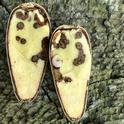
Interesting oak pests of 2023
From an entomologist's perspective, 2023 couldn't have been a more interesting year for oak pests! The first sign of great and awesome things to come was in the spring when it became clear many oaks were going to produce abundant acorns. I wouldn't call...
-
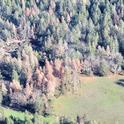
Bark Beetle Outbreaks and Conifer Mortality
I have been monitoring conifer mortality in Mendocino, Lake, Napa, and Sonoma Counties for the past year. Based on my observations and review of aerial detection surveys conducted by CAL FIRE Forest Health Specialists, the region is currently...


